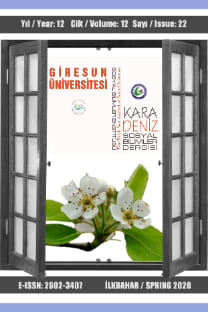Bir Keder Anısının Kişisel ve Toplumsal Boyutu: Alice Sebold’un Lucky: A Memoir Başlıklı Anısı
Roman ve kısa öykü gibi gerek kurgusal anlatılar gerekse biyografi, otobiyografi gibi kurgusal olmayan anlatılar insan yaşamı ve deneyimlerini ele aldığından daima insanların ilgisini çekerek okunmaktadır. Anı da kurgusal olmayan bir anlatı biçimi olup yazarın gerçek yaşam deneyimlerini yansıtması bakımından değerli ve ilgi çeken türler arasındadır. Amerikan yazar Alice Sebold'un Lucky: A Memoir başlıklı kitabı yazarın kendi travmatik deneyimini ve sonrasındaki psikolojik boyutu ele alan, dürüst ve sansürsüz anlatısından dolayı dikkat çeken bir keder anısıdır. Sebold bu eserinde okuduğu üniversite kampüsünde acımasızca dövülüp tecavüz edilme olayına ilişkin acı anılarını anlatırken olayın kendisinde bıraktığı derin duyguları dile getirmektedir. Lucky bir yandan tecavüz kurbanının yaşadığı travmatik öyküyü verirken öte yandan olay sonrasında yaşananların da önemini vurgulayan bir kitaptır. Bu çalışmanın amacı kitapta açıkça belli olan öznellikten yola çıkarak tecavüz olayının toplumsal boyutunun eserde yansımasını araştırmaktır. Sebold travmatik durumu aşma sürecindeki yaşanmışlıklarını verirken aslında eserine toplumsal bir boyut da kazandırmıştır. Bu çalışma, Lucky'yi kadının taciz ve tecavüz gibi türlü şekillerde şiddet görme olaylarına karşı toplumun bakışını değerlendiren ve bu anlamda toplumsal farkındalık yaratan bir eser olarak nitelendirmektedir. Denebilir ki, Sebold bu kitabında son derece kişisel bir tür olan anı türüne sosyal bir boyut kazandırarak, tecavüz kurbanı kadının bir de toplum tarafından anlaşılmayarak, suçlanarak ve dışlanarak iki kez kurban olmasının önüne geçmek istemiştir
The Personal and Social Dimension of a Misery Memoir: Alice Seabold’s Lucky: A Memoir
Both fictional narratives such as novel and short story and non-fictional accounts such as biography and autobiography deal with the human life and experience, and as such, they have been being read with interest. Memoir is also a form of non-fiction account and is among the valuable and interesting genres in terms of reflecting the author's real life experiences. The American author Alice Sebold’s book, Lucky: A Memoir is a misery memoir that draws attention to the author's own traumatic experience and its aftermath psychological dimension with its honest and uncensored narrative. In the work, Sebold describes the painful memories of being brutally beaten and raped on her college campus, and expresses the feelings of fear, loneliness, and despair left on in her by the incident. Whilst Lucky, is attesting, on the one hand, how a victim of rape tells of what kind of trauma she is experiencing, on the other hand, it emphasizes the significance of the aftermath of the rape. The purpose of this study is to investigate how the social dimension of rape is reflected in the book starting from the apparent subjectivity in it. While Sebold is giving her traumatic experiences in the process of coping with the situation in her book, she has, in effect, brought in a social dimension to her work. This study treats Lucky as a work that evaluates the society’s attitude towards molestation, and rape of women and violence against women in various forms, thus characterizes it as a work written to create awareness in the society. It would not be wrong to say that making memoir, which is a very personal genre, possess a social dimension Sebold wished to prevent the victim of rape from having double victimization resulting from not being understood, being accused and excluded by the society
___
Cline, Sally and Angier, Carole. (2010). The Arvon Book of Life Writing: Writing Biography, Autobiography and Memoir. Great Britain: Methuen Drama.Doerner, William G. ve Lab, Steven P. (2012). Victimology. Amsterdam ve Boston: Elsevier, Inc. Anderson Publishing.
Hacht, Anne Marie and Wilson, Greg (2006). Literary Newsmakers for Students. Volume I. USA: Thomson Gale.
Sebold, Alice. (1989). “Hers; Speaking the Unspeakable”. The New York Times. http://www.nytimes.com/1989/02/26/magazine/hers-speaking-of-the-unspeakable.html. Accessed on 25.12.2016.
Sebold, Alice (2002). “A Conversation with Alice Sebold”. Lucky. A Memoir. . Philadelphia: Little, Brown and Company Inc. pp. 1-10.
Sebold, Alice. (2002). Lucky: A Memoir. Philadelphia: Little, Brown and Company Inc. http://gen.lib.rus.ec/book/index.php?md5=2727AF6B53D5E42F34221CF9C2EBCB4A. Accessed on 01.10.2016.
van der Kolk, Bessel A., ve van der Hart, Onno. (1995). “The Intrusive Past: The Flexibility of Memory and the Engraving of Trauma”. Trauma: Explorations in Memory. (Ed. Cathy Caruth). Baltimore ve Londra: Johns Hopkins University Press, 158–182.
Wolhuter, Lorraine, Olley, Neil ve Denham, David. (2009). Victimology: Victimisation and Victims’ Rights. USA ve Canada: Routledge-Cavendish.
- ISSN: 2602-3407
- Yayın Aralığı: Yılda 2 Sayı
- Başlangıç: 2009
- Yayıncı: -
Sayıdaki Diğer Makaleler
Nil Deltasında Solmuş Bir Çiçek: Hypatia
Kaynakça Üniversitelerin “Kadın Çalışmaları Araştırma ve Uygulama Merkezleri”nin Rolü ve Önemi
REYHAN AYŞEN WOLFF, Zeynep Dilara DURMAZ, Onur ÇATALTEPE
Mürşide İçmeli’nin Sanat ve Eğitim Anlayışı
Aydın’ın Kadın Efeleri: Binbaşı Ayşe Aliye (Altuntaç)
Kız Çocukların Resimlerinin İzleğinde Şükriye Dikmen’in Kadın Portreleri
İslam’ın, Kadınların Kamusal Alanda Çalışmasına Bakışı
AYFER USTABAŞ, MİNE MUKADDES AFACAN FINDIKLI
18. Yüzyılda Pastel Portreler ve Bir Portre Ressamı Rosalba Carriera
